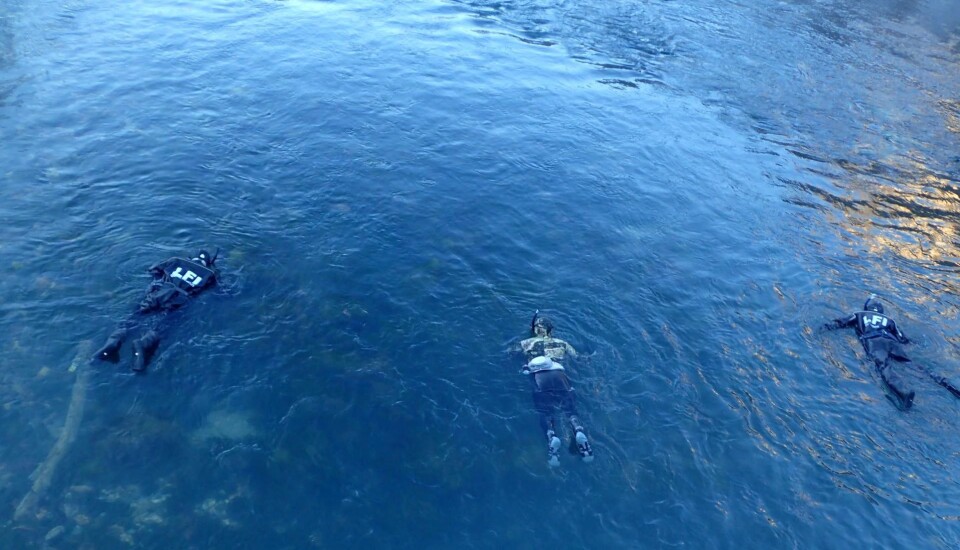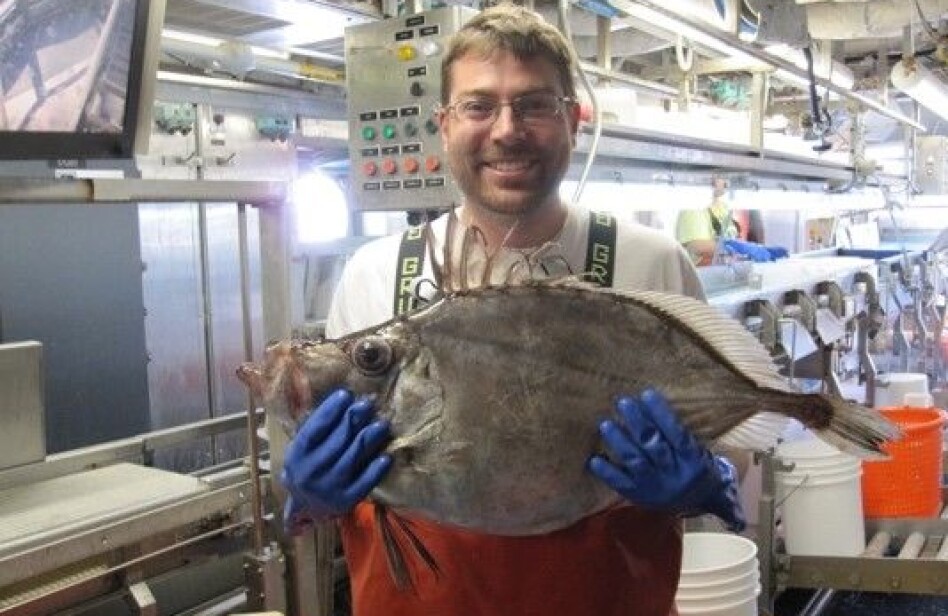Share your science:

Snorkeling rivers to count escaped farmed salmon
SHARE YOUR SCIENCE: Mission: Find out how many farmed salmon have escaped into the wild, threatening populations of wild salmon. Scientific method: Snorkeling.
On a brisk October morning, I found myself at the side of the Teigdalen river, a small tributary of the Vosso River, putting on a warm thermal layer along with what I hoped to be a waterproof dry suit. Then, grabbing my snorkel and diving mask, I entered the river in search of Atlantic salmon.
Following a more experienced diver to learn the ropes of snorkeling, I slowly drifted down the river trying to find my bearings. Then, I saw a glimmer of movement in the distance as we came upon the first fish of the day. Quickly realizing it was just a small brown trout, we continued on.
Finally, after about 30 minutes, I awkwardly crawled over a short riffle that was too shallow to float through and entered a nice still pool. There at the bottom was the unmistaken shape of two Atlantic salmon. As I slowly drifted over them, it felt like I could just reach out and touch them as they calmly swam below me. That day was my first introduction to the use of drift diving to count the number of returning Atlantic salmon from the ocean to spawn in their home rivers.
I grew up on the banks of the Yellowstone River in Montana, fishing various fish species. My only interaction with salmon came from my dreams where I hoped to someday catch one.
Today, I am a PhD student at the University of Bergen studying how domesticated Atlantic salmon that are accidently released from salmon farms interact with wild Atlantic salmon in rivers.
Unfortunately, Atlantic salmon populations have been declining worldwide and many populations are threatened by a range of human impacts. One of the most pressing issues facing many populations in Norway is the interbreeding between wild Atlantic salmon and those that originated from fish farms.

The tale of two salmon

The 1960s and 70s saw the birth of the salmon farming industry that we know today. It began by capturing wild salmon from populations that were known for their large size and over the last 60 years, husbandry practices continued to select larger fast-growing individuals. Today, the genetic signature of domesticated salmon is very different from their wild counterparts.
The development of net pens in the estuaries and fjords allowed for large scale aquaculture production. Sometimes though, the net pens fail and farmed salmon escape and migrate into rivers. Once in the river, they can mate with wild salmon and produce a cross between wild and farmed salmon called hybrids.
At the surface, hybrid look exactly like other wild salmon, however, extensive research has shown that the genetic mixing of wild and farmed salmon has unintended consequences. For instance, hybrids often cannot survive as well in nature compared to wild fish and depending on the level of introgression of the population - the level of genetic information that has been exchanged - could potentially result in the extirpation or removal of important populations from the rivers.
Differentiating between tourists and locals
Telling the difference between wild and domesticated salmon in rivers is like distinguishing between tourists and locals.
When farmed salmon escape from an aquaculture site when they are young, they are often more similar to wild salmon when they enter the rivers to spawn. This would be like going to the market and trying to distinguish between two people from adjacent towns. A lot of the time they are very similar in how they talk and interact with people.
However, if a farmed salmon escapes as an adult, they often are very different from wild fish in appearance and behavior. This is more attune to distinguishing two people from different regions where tourists from further away may use different words or phrases, perhaps they dress differently from the locals and can even have different accents making the difference much more apparent.

Different tails, spots and behavior
In the river, researchers use a range of characteristics to identify farmed salmon from wild fish.
One key feature is the erosion of the fins from net pen facilities. For instance, the caudal fins – meaning the tail – of wild salmon are very broad and triangular. Farmed salmon however often have more boxy caudal fins that appear to lack any type of efficiency needed to make the long-distance journeys typical of an Atlantic salmon.
The coloration of farmed fish can be very different as well, where salmon raised in captivity often have more spots than wild salmon. Finally, farmed salmon exhibit different behavioral characteristics and are more likely to flee when snorkelers approach where wild salmon can be much calmer and more docile.
In our study, we found that snorkeling allows divers to very accurately distinguish between wild and farmed salmon by focusing on these key differences between them. This is particularly important when developing management tools to limit the interactions between the two types of salmon.
What are we learning from snorkel counts of Atlantic salmon?
Our ability to identify farmed salmon in rivers has allowed us to improve how we manage the interactions between wild and farmed Atlantic salmon.
For instance, one fascinating aspect that we are currently studying with snorkeling counts is how farmed salmon select rivers to migrate up for spawning. One factor that contributes to the number of farmed salmon in rivers is the size of the wild population, where the larger wild populations attract more farmed salmon. This is particularly important when assessing the risk of the population and where to focus limited resources to reduce the interactions between wild and escaped salmon.
After about 5 hours in the river on that chilly fall day, we only found 8 wild salmon amongst us. While we always hope for more salmon, we were glad that we did not find any farmed salmon and, for now, the Teigdalen River is classified as at low risk for genetic introgression.
When I reflect back on my first interaction with such a beautiful and culturally important fish in their environment, I feel humbled from the experience. But perhaps more important at the time, my dry suit only had a small hole and only one leg was wet when I got back to the car.
Reference:
Mahlum, S., H. Skoglund, T. Wiers, E. S. Norman, B. T. Barlaup, V. Wennevik, K. A. Glover, K. Urdal, G. Bakke, and K. W. Vollset. 2019. Swimming with the fishes: validating drift diving to identify farmed Atlantic salmon escapees in the wild. Aquaculture Environment Interactions 11:417-427.
This work was a collaboration between NORCE Norwegian Research Centre and the Institute of Marine Research.
Share your science or have an opinion in the Researchers' zone
The ScienceNorway Researchers' zone consists of pinions, blogs and popular science pieces written by researchers and scientists from or based in Norway.
Want to contribute? Send us an email!






